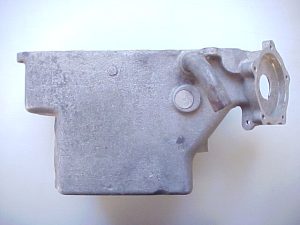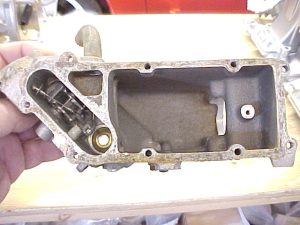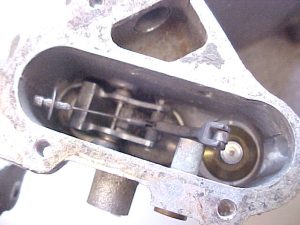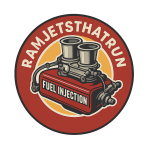The most difficult challenge in the Rochester repair world is getting a 4360, 4520, 4800, 4960, or 7300 FI system to work properly. It’s only been in the last few years that I’ve become confident these units can be made to run right. To get them to that level, you must make several modifications to the original designs, install perfect reproduction parts, and ensure every single component functions flawlessly. You Do-It-Ur-Selfers have now been warned.
You won’t have much of a problem getting strong full-throttle acceleration. That’s easy to do. It’s creating the right air/fuel ratio at low cruising speeds, getting a consistent and smooth idle speed, and starting easily when cold that will have you pulling your hair out with a ’57 unit. Here’s why.
All ’57 FI units were built with sand-cast fuel bowls. These bowls are very prone to “gumming up” with gas deposits, and they are extremely difficult to clean thoroughly. Gas varnish and corrosion sometimes hides between the steel spill valve sleeve and its aluminum casting bore. I haven’t found a sure way to remove and re-install this sleeve without scarring the bore. And once the bore is scarred, you darn sure can’t drill it oversize without also making some custom spill and fuel valve parts.



This is a typical ’57 fuel bowl. Over time, I have learned to hate this design. However, I do like the aluminum used in these castings. You can weld on it all day long, unlike the later fuel bowls made of pot metal.
The spill and fuel valves in sand-cast bowls must have extremely close fits in their bores to work properly. A .001″ side clearance is a relatively loose fit, and a .003″ clearance is completely unacceptable. However, both the spill and fuel valve pistons must move very freely in their bores. So freely, in fact, that they will fall out from their own weight when placed in the dry sleeve while you’re test-fitting them. This means you must carefully polish the sides without removing much material at all. Good luck with that.
The original axle links Rochester installed in the sand-cast bowls were very durable. It’s not uncommon to find them still being used fifty years after the units were first assembled. But durable is not everything an axle link in a ’57 unit needs to be. It must also be heavily counter-balanced to consistently return the spill valve to the exact position necessary for a proper idle mixture. I’ve found that Frank Antonicelli’s newest reproduction axle link design works better than any GM or other reproduction axle link in a sand-cast fuel meter. Its counterweight is much heavier than that of a Rochester ’57 axle link. That’s why I think Frank’s design works so well.
The main diaphragms GM put in their service “rebuild kits” were very good. Although the last batch of these diaphragms was made in 1975, most emerge in usable condition when found in NOS kits today. But the world is rapidly running out of NOS GM FI rebuild kits. Most of us have to make do with new reproduction diaphragms for our repair work. Here’s what you should look for in a repro main diaphragm for a ’57 FI unit: a high formed “hump” in the fabric around the magnesium center disc. Some of the modern repro diaphragms have almost no “hump”. If you use one of the flat repro diaphragms in your ’57 FI unit, you may not have enough sensitivity in your idle mixture screw to get a reliable idle speed. It could also limit the richness of your mixture under full acceleration.
The very first Rochester production design was the 7014360 FI series. These FI systems were such absolute turds that most were replaced by Chevy dealers before the ’57 model year was over. They can be salvaged these days, however, if you modify them to function more like the 4520 series design. You must replace the one-piece nozzles with a good set of two-piece nozzles, install a single spider design from a ’58 – ’62 series, fill the off-idle boost port with epoxy, seal the upper bearing on the distributor mainshaft, install a ’58 – ’63 enrichment diaphragm spring, and eliminate the Coasting Shut-Off system in the fuel meter. Actually, Chevrolet introduced all of these improvements as running changes in later FI design series.
The second FI series installed during the ’57 model year was the 7014520. This system was far from perfect, but it was a great improvement over the 4360 design. It used a single spider, had two-piece nozzles with internal screens, didn’t have a CSO system, and came with an upper bearing seal in the distributor. But, it still had an enrichment diaphragm spring that was too short, a poor cold enrichment system, and the unnecessary off-idle boost port.
For the 4520 design, Rochester also modified the 4360 cold enrichment system. They changed it in two ways, both of them making it worse. The cold enrichment housing now had an internal “pull-off” piston that leaned out the A/F ratio on start-up. That’s exactly when the fuel mixture needs to be super rich. Also, they sent plenum vacuum to the enrichment diaphragm immediately on cold start-up. That’s why a 4520 unit will usually die right after the first start in cold weather. There’s no way to keep the enrichment lever on the power stop for the first 30 seconds of running.
There isn’t an easy fix for the 4520 “choke” deficiencies. You can eliminate the pull-off piston, but you can’t make the enrichment lever stay on the power stop without installing a modified choke housing. And sure enough, that’s what Rochester did when they came out with the 7014800 series FI design. The 4800 cold enrichment housing has no pull-off piston and does have a valve keeping vacuum from going to the enrichment diaphragm initially.
But back to the 4520 design flaws… Rochester hadn’t yet figured out that the off-idle boost port (in the air meter bore) made low-speed cruise mixtures too rich. In fact, they increased the size of that detrimental boost port when they introduced the 4520 design! The port diameter was double the size used in the 4360 series! You absolutely must close this huge port or you’ll have low-speed cruising air / fuel ratios as rich as full acceleration A/F ratios! You WILL have some prematurely fouled spark plugs if you don’t plug this boost port.
By the time the 4800 FI series was introduced in mid-1957, Rochester was starting to see the problems caused by the off-idle boost port. They went back to a boost port size smaller than in the 4360 units. However, it still should be plugged to lean out the air / fuel mixtures while cruising at low speeds. As I explained above, Rochester improved the 4520 cold enrichment design for the 4800 series by removing the pull-off piston and installing a valve to keep the enrichment lever on the power stop initially.
The late-’57 7014960 and ’59 7017300 series were based on left over 7014800 parts. Therefore the modifications necessary to make them run properly are exactly the same as those for the 4800.
The fine-tuning of 4360 through 4960 units can only be done on a properly running engine. For example, it’s impossible to guess the right size for the restriction orifice inside the brass tee above the main diaphragm while on a workbench. You have to set the initial spark timing, run the unit until its fully warm, calibrate it under load, and then test its return-to-idle characteristics. If the engine sometimes dies rather than settle at a 750 rpm idle speed, then you may have too small an orifice in the tee. But maybe not.. it could also be a sticking spill valve, a plenum base vacuum leak, or an excessively lean idle mixture screw adjustment.
After making all these improvements, you’ll still have to solve the same problems found in all Rochester FI units: the lack of an anti-siphon electric solenoid, the need for a closely matched set of stock nozzles, the necessity of having an efficient gear pump, etc. However, I’m guessing those ordinary issues will be a lot easier to deal with than solving the special ’57 problems I’ve discussed in this write-up.
